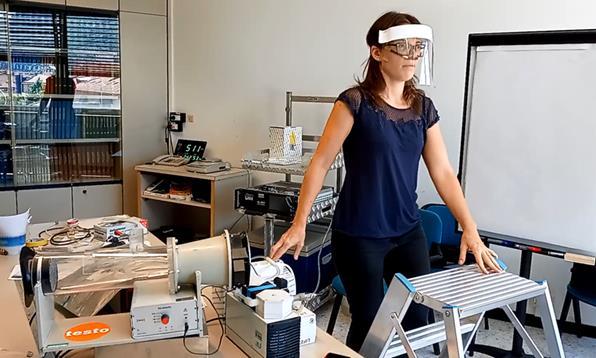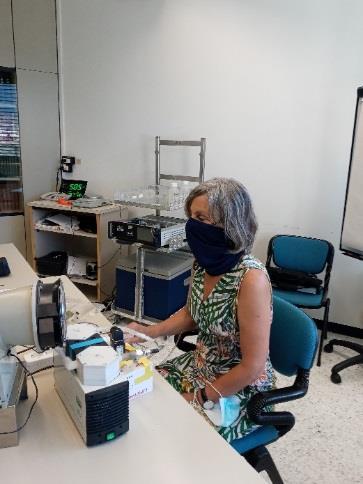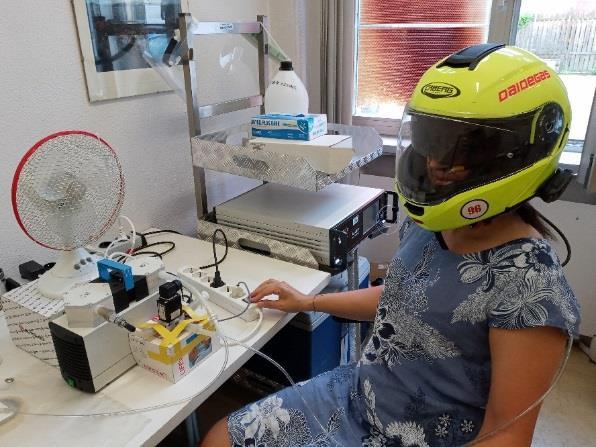
4 minute read
5. MODELS USED AND MEASUREMENT METHODS
5. MODELS USED AND MEASUREMENT METHODS
5.1 Parameters and indicators
The principal components of the air inhaled and exhaled by a person are oxygen (O2), carbon dioxide (CO2), nitrogen (N2), volatile organic compounds (VOC), biological agents and water vapor. Similar to the assessments of indoor air quality, CO2 is used as the principal indicator for the tests reported in this study. CO2 concentration can be measured with precision and its dilution in the air is also representative for any other compounds inhaled/exhaled. Measurements of O2 and TVOC were also carried out during the tests, however, the data elaborations reported in this study refer exclusively to CO2.
5.2 Inspired air
Sampling and measurement method used for the tests have two requirements:
1. To not interfere with breathing, that is, the analyzed air must be representative of what person actually inhaled. 2. Separate the air that enter the lungs (inhaled) from the air coming out (exhaled).
Measurement technique: at each respiratory act and during the entire inspiration phase a small amount of air is picked up through a probe placed between the nose and mouth and is collected in a Tedlar bag (PVDF) until full. The passage of air from the probe to the bag is managed by a pump that is activated only during the inhalation phase, whereas during exhalation, the pump is turned off and a valve inhibits any entry of air into the pump and therefore into the bag. The pump and valve are activated manually by the person carrying out the test, following their breathing pattern. The contents of the bag were then analyzed.
Figure 1 Figure 2



Figure 3 Figure 4
Sampling process: • a silicone tube with holes with a diameter of 4mm (internal) that wraps the head between the nose-mouth and the nape; • a PTFE pump regulated at a flow rate of approximately 1.4 L/min; • a valve that stop the air entering the pump during exhalation; • an activation command (pump and valve) which is managed by the person carrying out the test:
1. Inspiration: pump on and valve open. 2. Expiration: pump off and valve closed.
Figure 5. Sampling process
Sampling process is reported in Figure 5: 1 perforated silicone tube that wraps the head between the nose and mouth 2 valve 3 switch (manual operation) 4 pump 5 Tedlar bag.
Note: • Flow (1.4 L/min) is mantained low enough in order to not interfere with the pressure conditions present between the nose and mouth and with the device during the inspiration phase. • Separate Tedlar bags of 5L and 10L were used to contain inhaled and exhaled. • PTFE and silicone tubes were used to connect the various components of the sampling process. • The internal volume of the tubes from the probe to the valve was approximately 0.025L. • The duration of inspiration varied between 4 and 15 seconds. • The air volumes of a single inspiration varied from 0.8L to 2.5L • Duration of inspiration and volume of air inspired are not related, i.e. a short inspiration does not necessarily correspond to a smaller volume of air, because the person may have inspired for less time but with more force. • The volume taken from the pump during the inspiration phase depended on how long it remained active. The volumes therefore varied between 0.09L and 0.35L • The time that air moves from the sampling point to the valve was <1 second.
Tests were performed on these devices:
1. FFP2/KN95 mask 2. Surgical mask 3. Handcrafted mask 4. Screen/Visor 5. Neck warmer
Conditions of using the devices:
Preliminary tests
1. Sitting, without the device 2. Sitting, without the device with air speed of 0.5-1.0 m/s near the face (to simulate the effect of the wind or movement) 3. Sitting, with the device with air speed of 0.5-1.0 m/s near the face (to simulate the effect of the wind or movement).
Tests
4. Sitting with the device 5. Step: Light effort of stepping up/down with the device worna a stepping up/down was chosen in order to make uniform light effort for everyone. The test consisted of going up and down from the step at a slow pace.
5.3 Exhaled air
The exhaled air was collected in a Tedlar bag by exhaling inside an airtight mask connected to the bag by a silicone tube. The contents of the bag were than analyzed, in order to measure oxygen and carbon dioxide concentration.
5.4 Thermographic measurements
Using a thermographic camera, the surface temperatures of the face (with and without device) were measured at the beginning and the end of each test. The variation in surface temperature is an indicator of perceived discomfort.
5.5 Subjective analysis
Short questionnaires were distributed to the test persons (in Tables and diagrams - called Test 1 through n, n = 8) to describe their impressions and perceptions.
5.6 Device analysis
Concentrations of pollutants were analyzed for the devices (formaldehyde and VOC).
5.7 Instrumentation
Table describes the instrumentation used for the analyzes.
Parameter Measurement technique Instruments
O2 CO2 paramagnetism non-dispersive infrared HORIBA PG250
TVOC
photoionizer ION TIGER VOC gas chromatography HP 5973 Surface temperature infrared FLIR E6



